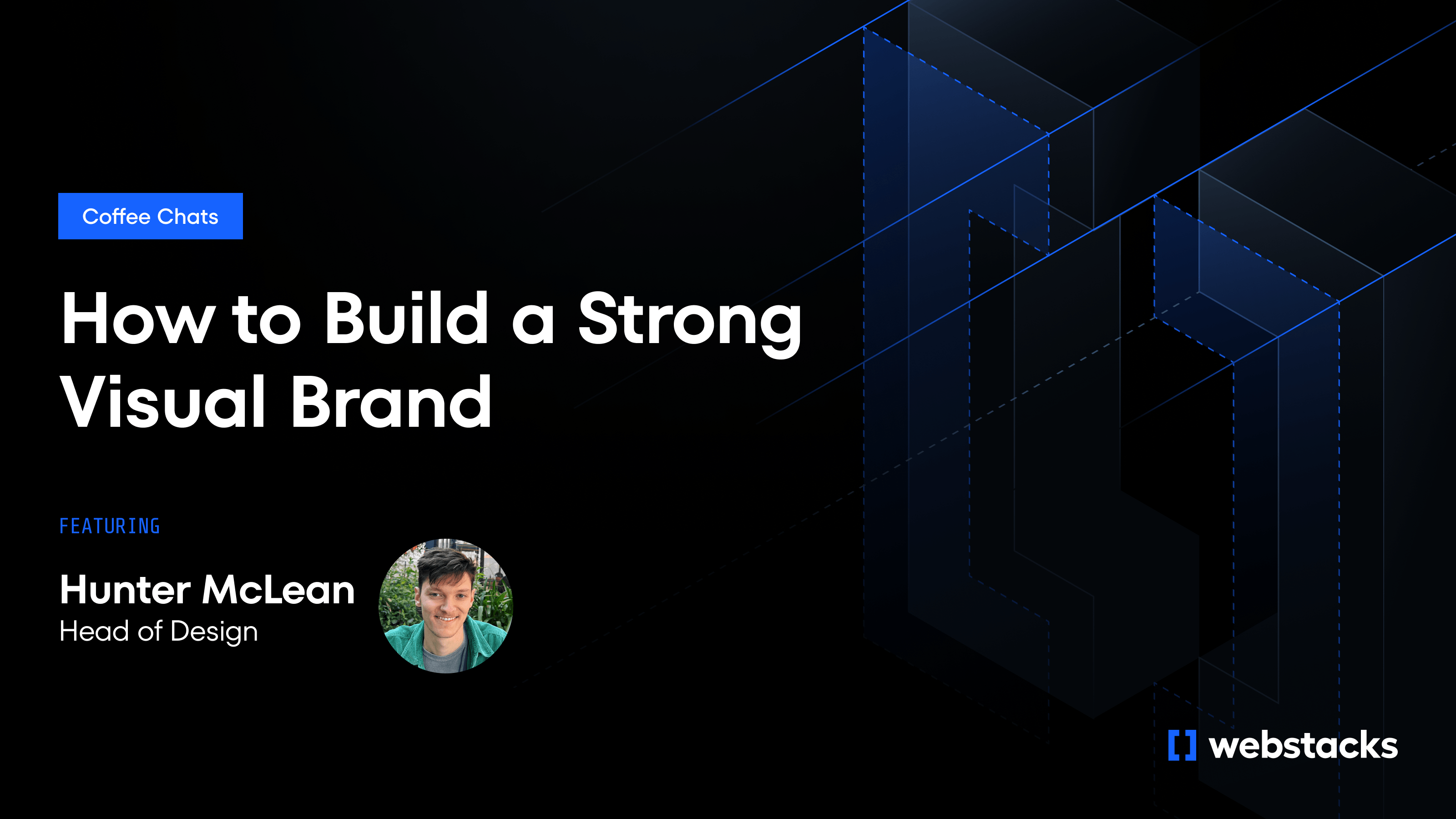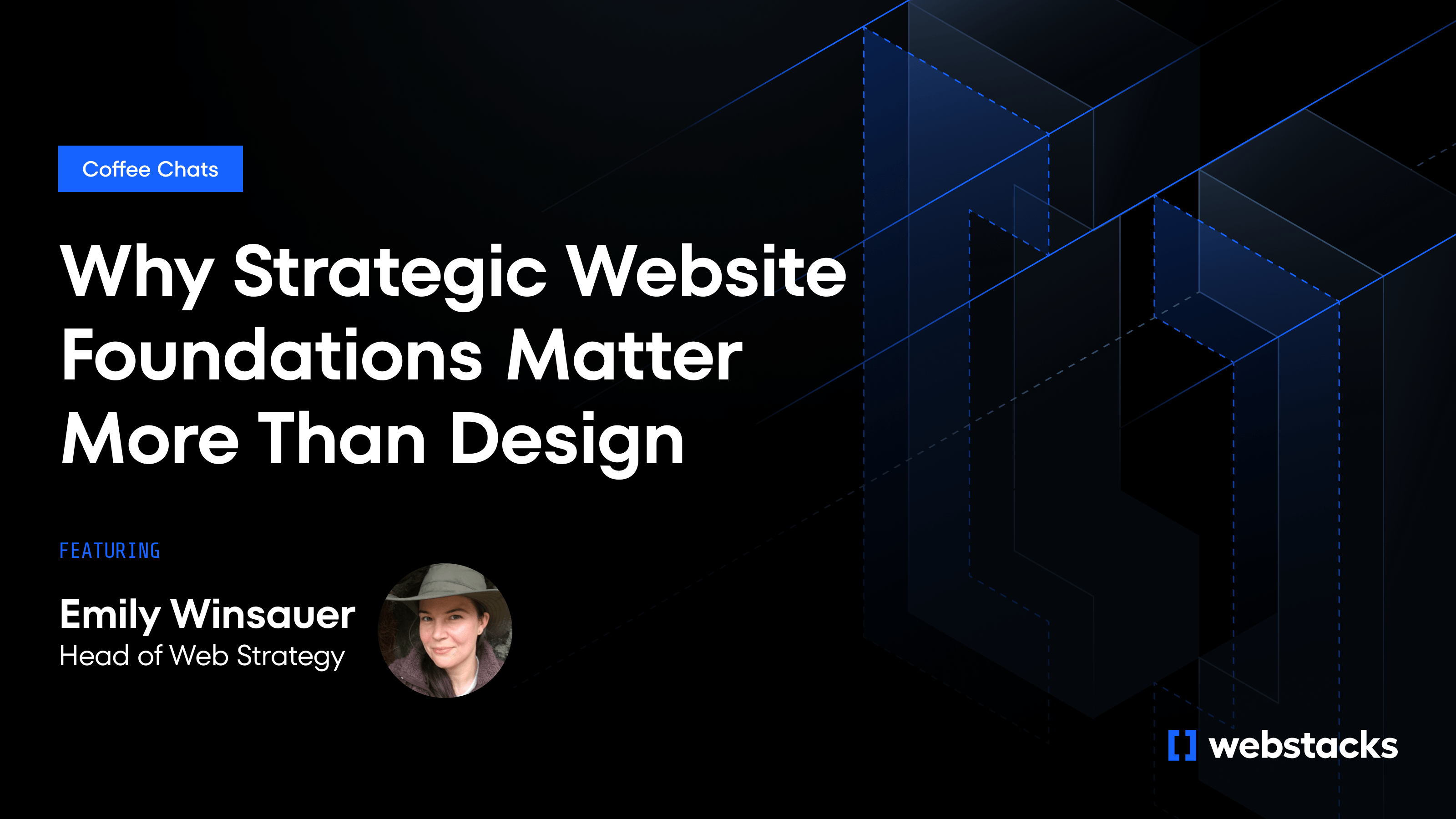Visual branding requires building trust, defining direction, and creating a cohesive identity that scales with your business.
I sat down with Hunter McLean, our Creative Director at Webstacks, to discuss how we help B2B SaaS companies with their visual branding and design process. Hunter has led dozens of brand transformations at Webstacks, working with everyone from startups with no visual identity to established companies like Gong. Here's what we covered about building visual brands that actually work.
Know Where You Are Before You Decide Where You're Going
The biggest mistake companies make with visual branding is starting without alignment. Hunter shared a story about a client who came to us for a website redesign. During their web presence workshop, questions about brand identity didn't land the way our team expected.
After three rounds of design concepts, the client came back with feedback that revealed the core issue: "There's nothing that resonates with what we want our brand to be." The root cause? They hadn't yet defined who they were as a brand.
"Nobody had an opinion," Hunter explained. "That made everything feel disjointed. You start relying on personal preference, which doesn't work because you're not building a website for yourself. You're building it for your company, which has a whole different personality."
The client paused the engagement, did internal brand work and returned with clarity. Only then could we build something cohesive.
Internal alignment on brand identity must happen before you touch design tools, but alignment alone won't translate into actionable design direction without a structured framework. For B2B SaaS companies building composable websites, this brand clarity becomes even more critical. When your website is built from modular components rather than static pages, every component needs to reflect consistent brand traits. Without that foundation, you end up with a Frankenstein site where each module looks like it came from a different company.
Start with Brand Traits, Not Design Preferences
We begin every branding engagement by identifying core brand traits. These are the adjectives that should come to mind when someone experiences your company.
"Brand traits are a designer's best tool," Hunter said. "You can pair 'energetic' with the word association exercise and derive design elements from that. Colors, typography, imagery, even corner rounding all flow from those traits."
Most companies skip this strategic foundation and jump straight to design preferences. Without an underlying strategy, those preferences become arbitrary fights over personal taste rather than decisions grounded in brand identity.
Companies with strong brands like Gong come to us with clear identity and consistent guidelines. "Our job is digesting who they are and figuring out how to maximize that for web," Hunter said. "Making a unique experience that feels bespoke, where they see themselves in their website."
Companies without brand clarity give conflicting feedback rooted in personal preference rather than brand strategy. We now invest significantly more time in brand discovery than we did years ago. We added the Revolution to Evolution scale, competitive landscape analysis and individual stakeholder surveys specifically to prevent misalignment downstream.
"We had some brand workshops that didn't go well," Hunter shared. "I asked myself: What isn't working here? Why is there so much feedback? Where is the missing link?"
The missing link was always strategy. Every successful brand transformation starts there.
Hunter walks clients through a structured framework that establishes strategy before touching design tools. We send stakeholder surveys individually before workshops to avoid groupthink diluting honest responses. The framework includes four core components that build on each other:
- Define brand traits that capture your company's personality in three adjectives
- Map positioning using our "Revolution to Evolution" scale to determine whether you want to evolve your existing brand or completely revolutionize it
- Analyze the competitive landscape to identify white space and differentiation opportunities
- Run word association exercises to surface visual themes that align with your brand traits
Individual feedback matters because group dynamics distort honest responses. "The group think was probably the worst part," Hunter admitted. "If I have five people in the room and do the exercise live, those five dots are going to be much closer together on each scale. When I send it out and everyone does it on their own, responses are way more varied. We get a truer representation of how people feel."
Individual feedback surfaces real disagreements that would otherwise stay hidden until they explode during design reviews. A product marketer might want the brand to feel "serious," while everyone else wants "playful." That tension needs to be addressed in discovery, not after three rounds of design.
As an outside agency, we have the flexibility to ask uncomfortable questions that internal teams can't. "I don't work for their company," Hunter noted. "I don't see those people every day. I don't have to play a political game. If there's a difference, we can talk about it. We can clear the air and see why two people are disagreeing."
Only after this groundwork does our design team start creating visuals. That competitive analysis piece grounds subjective design decisions in an objective market context.
Use the Competition as a Mirror, Not a Template
One of the most valuable exercises Hunter runs is competitive analysis. The process examines both immediate competitors and the entire category landscape to identify visual design patterns across the market.
Hunter walks through the logic: First, analyze direct competitors to understand where you need to stand out. Then expand the lens to examine the broader landscape—all the sales tools or platforms your buyers consider. The goal is spotting visual saturation points: color schemes, typography choices, imagery styles that dominate the category.
This dual analysis reveals where breaking patterns creates differentiation opportunities. When everyone in a category makes similar visual choices, those choices become invisible—buyers can't distinguish one brand from another. Strategic differentiation means identifying those saturation points and making deliberate choices that help you stand out.
Hunter walked through an example where competitors clustered around similar design choices. "Maybe let's not lean into purple if you see all of your competitors are using purple," he explained, "or maybe not leaning into a script font because you see that as a really common theme across your competitors."
Competitive analysis gives you design justification. You're not telling a stakeholder, "I don't think purple works." You're showing them "Here's why differentiating from this sea of purple will help you stand out."
This evidence-based approach makes decisions strategic rather than subjective. With strategy and competitive positioning locked in, the next phase translates those insights into tangible visual concepts.
Design Vignettes Build Trust and Buy-In Over Time
After brand strategy comes concept development. At Webstacks, this happens through vignettes: visual explorations that test different expressions of the brand based on everything learned in discovery.
The vignette process eliminates one designer and one concept direction at each phase. Round one presents three distinct concepts from three designers and stakeholders review to eliminate one direction. Round two refines the remaining two concepts based on feedback and the team identifies a winner. Round three has one lead designer finalize the chosen direction with polish and detail.
This phased approach prevents the "six weeks later, this isn't what we want" problem that derails branding projects. But even the best vignette process fails without the right feedback mechanism.
The vignette phase tests creative directions while building stakeholder confidence in the design process. This dual purpose prevents the common problem where clients see radical design changes for the first time at the end of a project and reject them because the evolution felt too abrupt.
"When we think about the process itself," Hunter explained, "we're showing them very different ideas. By the last round, they're bought into the radical changes we want to make. When we get into the design system phase, we're not wondering if they'll like this decision because it's so different. They're already bought in."
Vanilla Soft exemplified this. The team gave extensive feedback through three rounds of vignettes. By the final round, they were so aligned on the new brand aesthetic that they asked us to redesign their logo to match.
"That's an ideal case," Hunter said. "You're getting incremental approvals and building trust as you go. By the end, they're asking what else you can do to bring it to life."
Build Your Brand on Strategy, Not Preference
Strategic brand foundations determine how fast your marketing team can move. For B2B SaaS companies, clear visual direction reduces decision friction, accelerates content production and creates consistency across every customer touchpoint. Marketing teams launch campaigns faster when design decisions are codified in reusable systems rather than relitigated with each new asset.
The cost of weak brand foundations compounds over time. Without strategic clarity, launching a new landing page becomes a negotiation. Campaign assets trigger multiple rounds of stakeholder feedback while website updates introduce visual inconsistencies that dilute brand recognition and erode buyer trust. These inefficiencies drain budget and create team friction beyond just slowing marketing down.
Companies that invest in strategic brand work see measurable returns: faster campaign launches, fewer design iteration cycles and marketing teams that execute independently without constant creative review. That autonomy only works when the underlying brand system is solid.
"Nothing's going to land if you don't know who you are," Hunter said. "Everything will feel disjointed. You'll rely on personal preference, which doesn't work because you're not building for yourself. You're building for a company that has a whole different personality."
The best visual brands get built by teams who do the strategic work first. For B2B SaaS companies treating their websites as products rather than projects, that strategic foundation becomes the system that enables continuous improvement, faster launches and marketing autonomy at scale.
Ready to build a visual brand that scales with your business? Talk to Webstacks about our brand discovery and design process.




